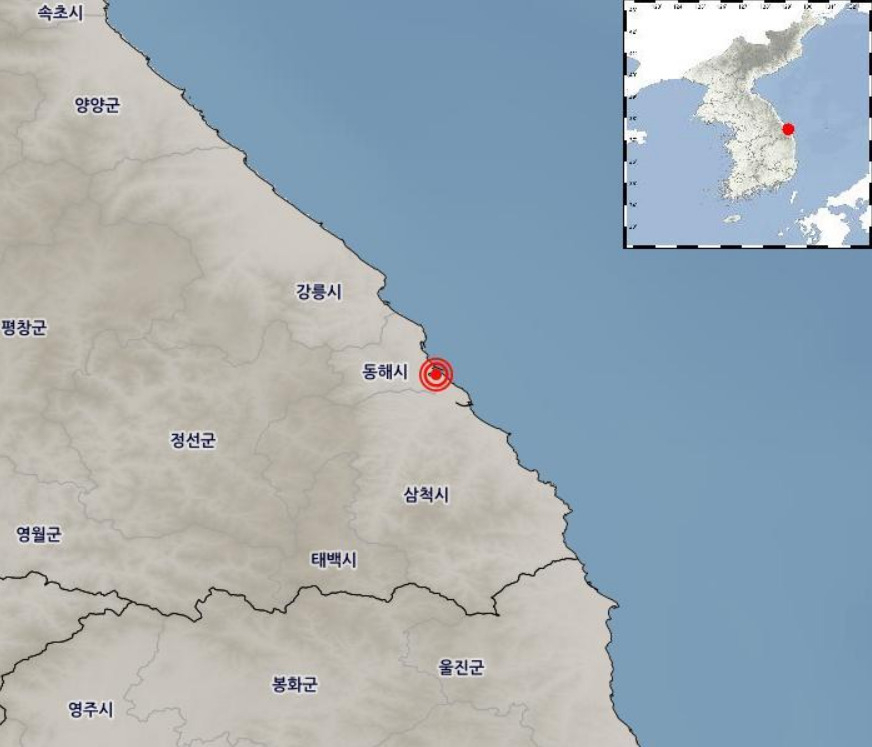'Earthquake swarm' hits East Sea
Experts say it is too early to worry about large disasters, but precautions needed
By Lee Jung-younPublished : May 10, 2023 - 15:52

A cluster of minor earthquakes and tremors have hit Donghae, Gangwon Province, this year in a rare phenomenon known as an "earthquake swarm."
The latest was a magnitude 2.5 earthquake struck at 4:32 p.m. on Wednesday, 4 kilometers south of Donghae, marking a total of 44 earthquakes around the area this year, according to the Korea Methodological Agency.
An earthquake swarm is defined as relatively small earthquakes clustered within a small area and short period. Of the 44 earthquakes that occurred in Donghae this year, 14 earthquakes had a magnitude of 2.0 or higher, and the other 30 earthquakes were micro-earthquakes weaker than 2.0, according to the KMA. The strongest was a 3.1 magnitude earthquake that occurred on April 25 in waters 50 kilometers northeast of Donghae.
Experts say while it is too early to worry about any disasters, certain changes in earthquake trends surrounding the Korean Peninsula have been observed.
Professor Kim Young-Seog of Pukyong National University's Department of Earth and Environmental Sciences said earthquake swarms can be a precursor to larger earthquakes.
“If we mark the location of recent earthquakes on a map, they form lines, which means that the possibility of a single fault being shaken repeatedly is considerable," Kim told The Korea Herald.
"The fault, which receives stress due to continuous tremor, might cause a major earthquake at some point. It is clear that we have to keep an eye on the trend.” Kim, based on historical records, had predicted an earthquake before the 5.8 magnitude Gyeongju earthquake in 2016.
But at the same time, Kim added that earthquake swarms have not always led to huge earthquakes. Earthquake swarms had been detected in 2013, during which 60 earthquakes struck waters near Boryeong, South Chungcheong Province, and in 2020, when there were 70 earthquakes in waters near Haenam, South Jeolla Province. Both earthquake swarms did not lead to large disasters.
Kim also explained that the fault responsible for recent earthquake swarms seems to be relatively small compared to major faults in the East Sea, which alleviates the concern over impending large disasters.
"Major faults in the East Sea, which are able to cause large earthquakes that could affect inland, appear in the north-south direction, while the locations of recent earthquakes are distributed in the north-east direction," he said.
Professor Hong Tae-kyung, director of the Earth System Sciences Research Center at Yonsei University, echoed Kim’s claim that it is too early to say any disaster is coming, but said recent earthquakes happening around the Korean Peninsula have been different from the past.
According to Hong, the recent earthquakes can be divided into two groups: ones happening at sea about 50 km away from land, and ones happening on land. Hong explained that two groups of earthquakes are located on different faults, but both have unusual characteristics.
“Both earthquake swarms and earthquakes happening in relatively deep areas -- more than a depth of 20 km -- were not easily found around the Korean Peninsula historically, but recent tremors are showing both characteristics. This change has been witnessed since the Tohoku earthquake in 2011, an earthquake with a devastating magnitude of 9.1 and more than 15,000 casualties,” explained Hong.
The Tohoku earthquake has stretched the Korean Peninsula, about 3 centimeters from east to west, making it relatively unstable land, Hong said.
"Although we cannot affirm that a large disaster is coming up, certainly meaningful changes have been made under the Korean Peninsula, and we should keep an eye on it,” said Hong.
Seo Yong-seok, a professor at the Department of Earth and Environmental Science at Chungbuk National University, said "there is no such thing as ‘100 percent sure’" in predicting earthquakes, but added that there has been enough momentum to warrant thorough precaution of major earthquakes.



![[Exclusive] Korean military set to ban iPhones over 'security' concerns](http://res.heraldm.com/phpwas/restmb_idxmake.php?idx=644&simg=/content/image/2024/04/23/20240423050599_0.jpg&u=20240423183955)

![[Graphic News] 77% of young Koreans still financially dependent](http://res.heraldm.com/phpwas/restmb_idxmake.php?idx=644&simg=/content/image/2024/04/22/20240422050762_0.gif&u=)



![[Pressure points] Leggings in public: Fashion statement or social faux pas?](http://res.heraldm.com/phpwas/restmb_idxmake.php?idx=644&simg=/content/image/2024/04/23/20240423050669_0.jpg&u=)










